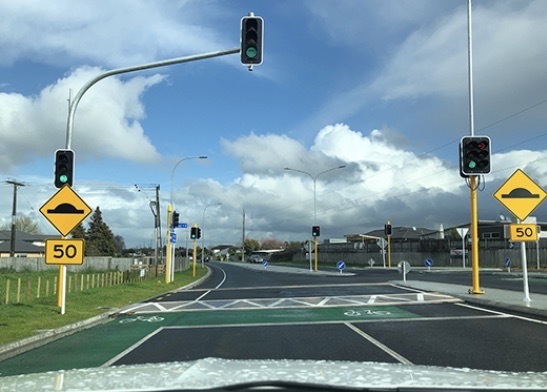New approach to pedestrian crossing causes delay
Diana Cocks
01 November 2022, 4:06 PM
 Raised safety platforms, also known as courtesy crossings, have been a part of Wānaka’s CBD for years. PHOTO: Wānaka App
Raised safety platforms, also known as courtesy crossings, have been a part of Wānaka’s CBD for years. PHOTO: Wānaka AppThe long-awaited safe pedestrian crossing of Ballantyne Road near the Wānaka Golf Club entrance has been postponed until 2023 as the proposed signalised crossing is re-engineered.
Pedestrian activated traffic lights, a first in Wānaka, were to be installed to provide a safe pedestrian/cycle crossing point and in May this year the Wānaka Community Board (WCB) was advised the project was in the design phase with construction anticipated to start in August.
Queenstown Lakes District Council (QLDC) media advisor Sam White said the intention was to start the project over winter but the planning and design phase was extended “to ensure the crossing is done right”.
The council now plans to incorporate wide speed humps, also known as “raised safety platforms”, on either side of the traffic signals which will meet New Zealand Transport Authority (NZTA) requirements, Sam said.

NZTA said the combination of raised safety platforms and traffic lights was first introduced in 2019 by Hamilton City Council to slow traffic approaching a high-speed major road junction on the outskirts of the city. PHOTO: NZTA
It also intends to introduce the same combination of traffic lights and speed humps on Aubrey Road near the Holy Family School at the start of the Schools to Pool cycle safety project.
“The current focus is ensuring new crossings are built in line with latest best practice,” Sam said.
Raised safety platforms have been a part of Wānaka’s roading landscape for years providing ‘courtesy’ pedestrian crossings along Ardmore and Helwick Streets, and on Sir Tim Wallis Drive in Three Parks.
The combination of raised platforms and traffic lights activated by pedestrians in a low speed environment, however, is a first in New Zealand, according to NZTA.
“We are not aware of any other local road (ie council managed) signalised, pedestrian crossings with raised platforms in smaller, low traffic volume townships with very low incidence of crashes,” NZTA senior road safety manager Fabian Marsh said.
The combined raised platforms and traffic lights approach is more costly (NZTA estimates $40,000-$50,00 per raised platform) than the original plan, but will it make these Wānaka crossings safer when the speed limit is already 40km/h or slower (30km/h outside the school)?
Council staff declined to tell the Wānaka App what added safety benefit this approach would have in a slow speed environment and suggested we ask NZTA.
NZTA said “it is great to see QLDC putting the safety of pedestrians and others first” but acknowledged it would be difficult to differentiate between the benefits resulting from the raised safety platforms and those from the signalised intersection.
Fabian said traffic signals help to reduce the frequency of harm occurring but they do not manage the consequence when a mistake occurs.
Raised pedestrian crossings, however, reduce a vehicle’s speed to 30km/h “which means that if something goes wrong, the pedestrian or cyclist could walk away from a collision without serious injury”, he said.
Sam did not specify how much more the redesign and added platforms would add to the project’s budget, but said: “The final cost for the Ballantyne Rd crossing will be the total required to meet code of practice requirements”.
The QLDC has no current plans to retrofit its other signalised pedestrian crossings with raised platforms, he said.
Construction of the crossings on Ballantyne and Aubrey Roads is currently out to tender and council expects to select the chosen contractor in late November, Sam said.
Pending that decision, council expects construction to begin somewhere between January and March 2023.






